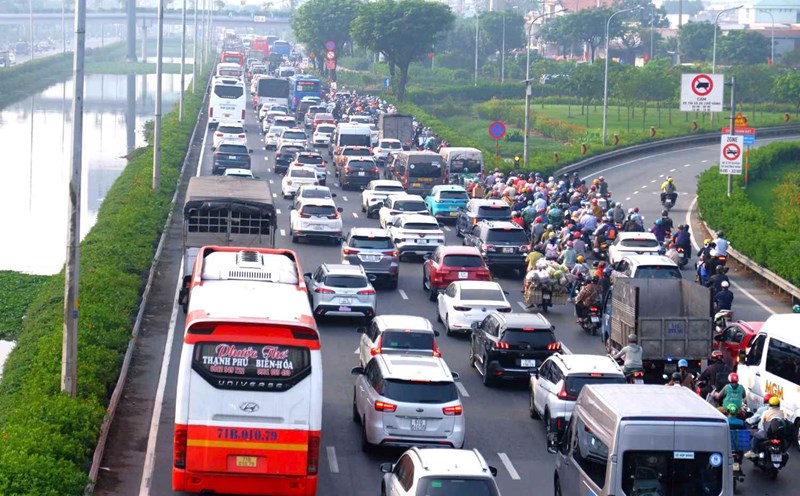Upgrading 4 key gateways
For many years, the gateway routes of Ho Chi Minh City have been continuously congested due to overload. The main reason is the lack of capital to expand according to the plan. Currently, the city budget only meets about 20% of the demand for investment in transport infrastructure, making mobilizing resources from society an urgent requirement.
Resolution 98 of the National Assembly has opened up new opportunities for Ho Chi Minh City, including allowing the re-deployment of BOT (build - operate - transfer) investment on existing routes.
Director of the Ho Chi Minh City Department of Transport Tran Quang Lam said that the department has just submitted to the Ho Chi Minh City People's Committee a pre-feasibility study report for 4 projects to expand the city gateway.
The northeastern gateway, National Highway 13 (from Binh Trieu Bridge to Vinh Binh Bridge) is 6.3km long and will be expanded from the current 19 - 27m to 60m. In particular, more than 3.2km in the middle of the route will be built with a 4-lane overpass, combined with a 6-lane parallel road on both sides. The total investment of the project is more than 21,700 billion VND.
The southern gateway, the 8.6km long North-South axis road (from Nguyen Van Linh Avenue to Ben Luc - Long Thanh Expressway) will also be expanded to 60m. A part of the route, over 7km long, will be built with a 4-lane overpass. The total investment capital is about 9,900 billion VND.
The western gateway, National Highway 1 - the section passing through Binh Tan and Binh Chanh districts, nearly 10km long (from Kinh Duong Vuong intersection to Long An border), will be expanded to 60m, accommodating 10-12 lanes. The total estimated investment is about VND 16,270 billion.
The Northwest gateway, National Highway 22 (from An Suong intersection to Ring Road 3) is more than 8km long, and will be expanded to 60m, accommodating 10 lanes. The total preliminary investment capital is about 10,451 billion VND.
Construction started in 2026 and completed in 2028
According to the Ho Chi Minh City Department of Transport, the above 4 projects will be submitted to the Ho Chi Minh City People's Council for approval of the investment policy this February. If approved, site clearance will take place this year, starting in 2026 and completing in 2028.
The Director of the Ho Chi Minh City Department of Transport commented that accelerating the expansion of gateway routes not only helps reduce inner-city congestion but also improves the efficiency of exploitation of major traffic projects such as Ring Road 3, Ho Chi Minh City - Moc Bai Expressway, Ho Chi Minh City - Chon Thanh. At the same time, the completion of infrastructure will also promote the exploitation of land funds on both sides of the route, creating momentum for economic development for the city and the Southeast region.
According to Dr. Vo Kim Cuong - former Deputy Chief Architect of Ho Chi Minh City, prolonged congestion at the city's gateways leads to two serious consequences. Firstly, traffic jams from gateways will spread to the inner city, paralyzing city traffic, and there will be no effective solutions. Second, the gateways are the commercial artery of Ho Chi Minh City with neighboring provinces. When traffic stagnates, economic activities are also seriously affected, reducing the city's investment attraction.
Ho Chi Minh City has a great advantage with many multi-directional gateways, helping to gather resources for development. If not expanded in time, the city will gradually lose its position as the economic center of the region" - Mr. Vo Kim Cuong emphasized.
Mr. Vo Kim Cuong said that in the current context, Ho Chi Minh City has no choice but to focus resources to immediately complete gateway expansion projects. The closure of the beltway system will help reduce pressure on inner-city routes, creating conditions for implementing the policy of population dispersion and developing multi-centered urban areas.












